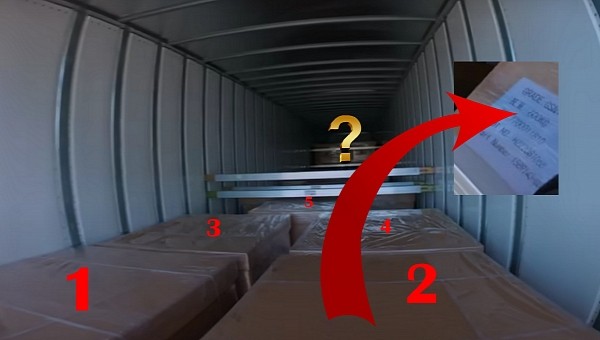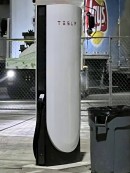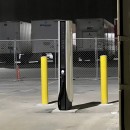The Tesla Semi is seen in two very different ways. Tesla fans and investors celebrate its acceleration times and think it is a revolution. Truck drivers and engineers do not get enough from bashing it – for multiple reasons. John Cadogan refers to it in NSFW terms. The Australian journalist, engineer, and YouTube did the math on it, and it simply does not add up.
His main finding is the allegation that the electric Class 8 truck recovers 70% of its charge in 30 minutes. Cadogan made interesting calculations to show there was something wrong with that.
According to Tesla, the Semi made a 500-mile (804.7-kilometer) trip spending only 2 kW/mile. That means its battery pack holds at least 1 MWh: 2 kWh/mile times 500 mi. The company promised its Supercharger V4 would deliver 1 MW. That’s the tool Tesla has to recover 70% of the Semi’s charge in 30 minutes.
If the total range of the Semi is 500 miles, 70% means 350 mi (563.3 km). However, 1 MW feeding a battery pack for half an hour only provides 500 kWh – or 50% of what the Semi battery pack can hold. In other words, 250 miles of range. The Semi would only recover 70% of charge at 1 MW in a bit more than 42 minutes.
Estimating the battery pack size allowed Cadogan to calculate how heavy the battery pack must be. The engineer used the energy density of lithium-ion cells to reach that number. According to Cadogan, it sits between 180 kW/metric ton and 200 kW/metric ton. If the energy density were the first one, the battery pack should weigh 5,556 kilograms (12,248.9 pounds). If it were the second, the weight would drop to 5,000 kg (11,023 lb).
That helped the engineer estimate that the Semi weighs around 19,000 kg (41,888 lb), considering a combustion-engine Class 8 truck tips the scale at approximately 14,000 kg (30,865 lb).
After he posted his first video, Cadogan saw it was the most hated video he had shared in ages. Some commenters tried to argue that Cadogan should have subtracted the weight of the engine, gearbox, and other components used by regular trucks for a proper comparison. The engineer replied with a fair observation: electric cars are always heavier than ICE vehicles.
He compared vehicles that have an electric derivative with their versions that only use engines. In all cases, the EV derivatives were heavier than their ICE counterparts. More than that: they were heftier than their battery packs alone would suggest. The reason is simple: although BEVs theoretically only add the battery pack, they also need inverters, chargers, and several other components that a combustion-engined passenger car does not have. Cadogan even challenged anyone to present an exception to that rule.
The engineer then argued something else: Tesla would not have omitted the Semi’s weight if it was not a (massive) Achilles’ heel. On the contrary: it would brag about it as much as Tesla is bragging about how fast the truck can accelerate – something no truck driver ever wanted. Acceleration times from 0 to 60 mph are not a concern for truck companies: how much stuff they can carry is. In that regard, the Semi will probably take a beating from any ICE competitor.
Cadogan made a mistake in his first video: he thought electric trucks had the same gross-vehicle-weight (GVW) limit imposed on combustion-engined semi-trucks. In fact, it was a bit worse than that: he worked with the information Elon Musk gave when he bragged about the 500-mi trip on Twitter. The Tesla CEO said it had a GVW of 81,000 lb (36,741 kg).
The truth is that Class 8 trucks have an 80,000-lb (36,287 kg) GVW limit in the U.S., meaning that’s all they can carry, counting the truck, the trailer, and the load. The American government gave electric trucks a higher limit: 82,000 lb (37,195 kg). Cadogan acknowledges at least part of that in his second video.
At first, the engineer calculated that ICE trucks would have a 21% payload advantage. After correcting the numbers, he reduced that edge to 12.5%. A transportation company with 40 trucks would need 46 Semis to perform the same job. If it had two drivers per truck, it would have 96 drivers instead of 80. The cost handicap it would face for “going green” with Tesla is more than evident – and all Cadogan's estimates may still be better than the numbers the electric truck actually presents.
It is worth watching the two videos to follow his reasoning. Just be careful not to do that without headphones: as we said right at the beginning, Cadogan does not hold back in his thoughts about what the Semi is. Children and prudish people may get offended. Tesla investors certainly will.
According to Tesla, the Semi made a 500-mile (804.7-kilometer) trip spending only 2 kW/mile. That means its battery pack holds at least 1 MWh: 2 kWh/mile times 500 mi. The company promised its Supercharger V4 would deliver 1 MW. That’s the tool Tesla has to recover 70% of the Semi’s charge in 30 minutes.
If the total range of the Semi is 500 miles, 70% means 350 mi (563.3 km). However, 1 MW feeding a battery pack for half an hour only provides 500 kWh – or 50% of what the Semi battery pack can hold. In other words, 250 miles of range. The Semi would only recover 70% of charge at 1 MW in a bit more than 42 minutes.
Estimating the battery pack size allowed Cadogan to calculate how heavy the battery pack must be. The engineer used the energy density of lithium-ion cells to reach that number. According to Cadogan, it sits between 180 kW/metric ton and 200 kW/metric ton. If the energy density were the first one, the battery pack should weigh 5,556 kilograms (12,248.9 pounds). If it were the second, the weight would drop to 5,000 kg (11,023 lb).
That helped the engineer estimate that the Semi weighs around 19,000 kg (41,888 lb), considering a combustion-engine Class 8 truck tips the scale at approximately 14,000 kg (30,865 lb).
After he posted his first video, Cadogan saw it was the most hated video he had shared in ages. Some commenters tried to argue that Cadogan should have subtracted the weight of the engine, gearbox, and other components used by regular trucks for a proper comparison. The engineer replied with a fair observation: electric cars are always heavier than ICE vehicles.
He compared vehicles that have an electric derivative with their versions that only use engines. In all cases, the EV derivatives were heavier than their ICE counterparts. More than that: they were heftier than their battery packs alone would suggest. The reason is simple: although BEVs theoretically only add the battery pack, they also need inverters, chargers, and several other components that a combustion-engined passenger car does not have. Cadogan even challenged anyone to present an exception to that rule.
The engineer then argued something else: Tesla would not have omitted the Semi’s weight if it was not a (massive) Achilles’ heel. On the contrary: it would brag about it as much as Tesla is bragging about how fast the truck can accelerate – something no truck driver ever wanted. Acceleration times from 0 to 60 mph are not a concern for truck companies: how much stuff they can carry is. In that regard, the Semi will probably take a beating from any ICE competitor.
Cadogan made a mistake in his first video: he thought electric trucks had the same gross-vehicle-weight (GVW) limit imposed on combustion-engined semi-trucks. In fact, it was a bit worse than that: he worked with the information Elon Musk gave when he bragged about the 500-mi trip on Twitter. The Tesla CEO said it had a GVW of 81,000 lb (36,741 kg).
The truth is that Class 8 trucks have an 80,000-lb (36,287 kg) GVW limit in the U.S., meaning that’s all they can carry, counting the truck, the trailer, and the load. The American government gave electric trucks a higher limit: 82,000 lb (37,195 kg). Cadogan acknowledges at least part of that in his second video.
At first, the engineer calculated that ICE trucks would have a 21% payload advantage. After correcting the numbers, he reduced that edge to 12.5%. A transportation company with 40 trucks would need 46 Semis to perform the same job. If it had two drivers per truck, it would have 96 drivers instead of 80. The cost handicap it would face for “going green” with Tesla is more than evident – and all Cadogan's estimates may still be better than the numbers the electric truck actually presents.
It is worth watching the two videos to follow his reasoning. Just be careful not to do that without headphones: as we said right at the beginning, Cadogan does not hold back in his thoughts about what the Semi is. Children and prudish people may get offended. Tesla investors certainly will.




























